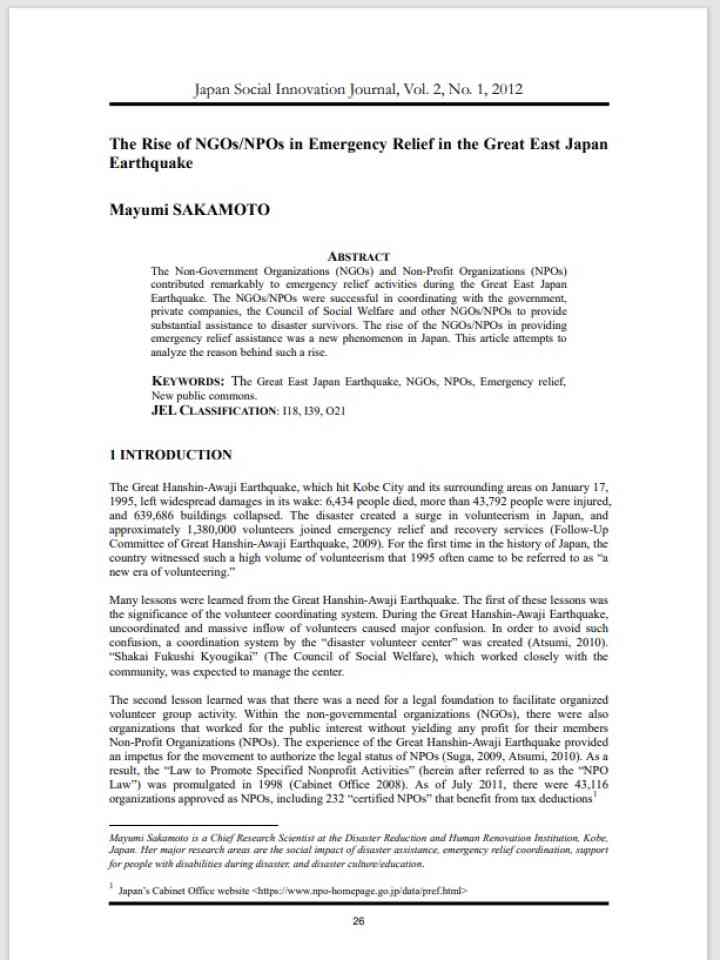The Rise of NGOs/NPOs in Emergency Relief in the Great East Japan Earthquake
The Great Hanshin-Awaji Earthquake, which hit Kobe City and its surrounding areas on January 17, 1995, left widespread damages in its wake: 6,434 people died, more than 43,792 people were injured, and 639,686 buildings collapsed. The disaster created a surge in volunteerism in Japan, and approximately 1,380,000 volunteers joined emergency relief and recovery services (Follow-Up Committee of Great Hanshin-Awaji Earthquake, 2009). For the first time in the history of Japan, the country witnessed such a high volume of volunteerism that 1995 often came to be referred to as "a new era of volunteering."
Many lessons were learned from the Great Hanshin-Awaji Earthquake. The first of these lessons was the significance of the volunteer coordinating system. During the Great Hanshin-Awaji Earthquake, uncoordinated and massive inflow of volunteers caused major confusion. In order to avoid such confusion, a coordination system by the "disaster volunteer center" was created (Atsumi, 2010). "Shakai Fukushi Kyougikai" (The Council of Social Welfare), which worked closely with the community, was expected to manage the center.
The second lesson learned was that there was a need for a legal foundation to facilitate organized volunteer group activity. Within the non-governmental organizations (NGOs), there were also organizations that worked for the public interest without yielding any profit for their members Non-Profit Organizations (NPOs). The experience of the Great Hanshin-Awaji Earthquake provided an impetus for the movement to authorize the legal status of NPOs (Suga, 2009, Atsumi, 2010). As a result, the "Law to Promote Specified Nonprofit Activities" (herein after referred to as the "NPO Law") was promulgated in 1998 (Cabinet Office 2008). As of July 2011, there were 43,116 organizations approved as NPOs, including 232 "certified NPOs" that benefit from tax deductions
The year 2011 could be referred to as "an era of NGOs/NPOs." The Great East Japan Earthquake that occurred on March 11 caused widespread damage in Eastern Japan, and left over more than 20,000 people dead or missing. It was difficult to set up disaster volunteer centers in several municipalities owing to the physical damage and human loss. In such a situation, the NGOs/NPOs began providing assistance to the survivors. The liaison from NGOs/NPOs took a seat in the on-site Government Disaster Management Local Headquarters established in Miyagi Prefecture (here in after referred as "government on-site headquarters") and coordinated with the government, private companies, the Council of Social Welfare and other NGOs/NPOs to provide better support to survivors. This collaborative effort between the NGOs/NPOs and the government was referred to as the "New Public Commons" in the Reconstruction Design Council's report to Prime Minister in response to the Great East Japan Earthquake.
This article focuses on the first three months after the Great East Japan Earthquake and attempts to analyze the reason behind the rise of NGOs/NPOs in providing emergency assistance. First, the article reviews volunteer and NGO/NPO mobilization to identify the limitations and improvements of the current system. Second, the article focuses on the collaborative efforts of the NGOs/NPOs and the government. Finally, based on this discussion, the article analyzes the reason for their rise and proposes the role of NGOs/NPOs in case of future disasters.
Explore further
